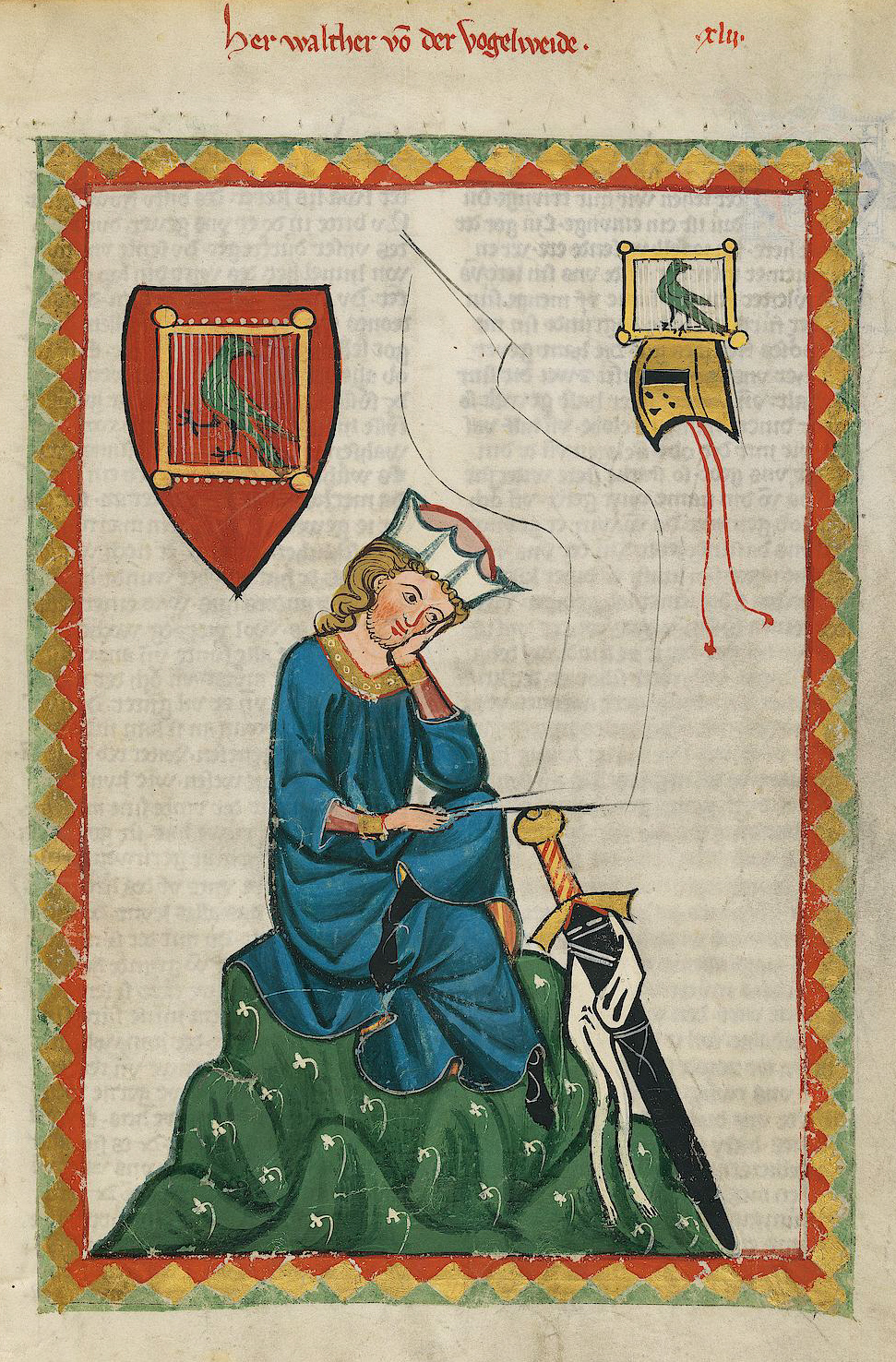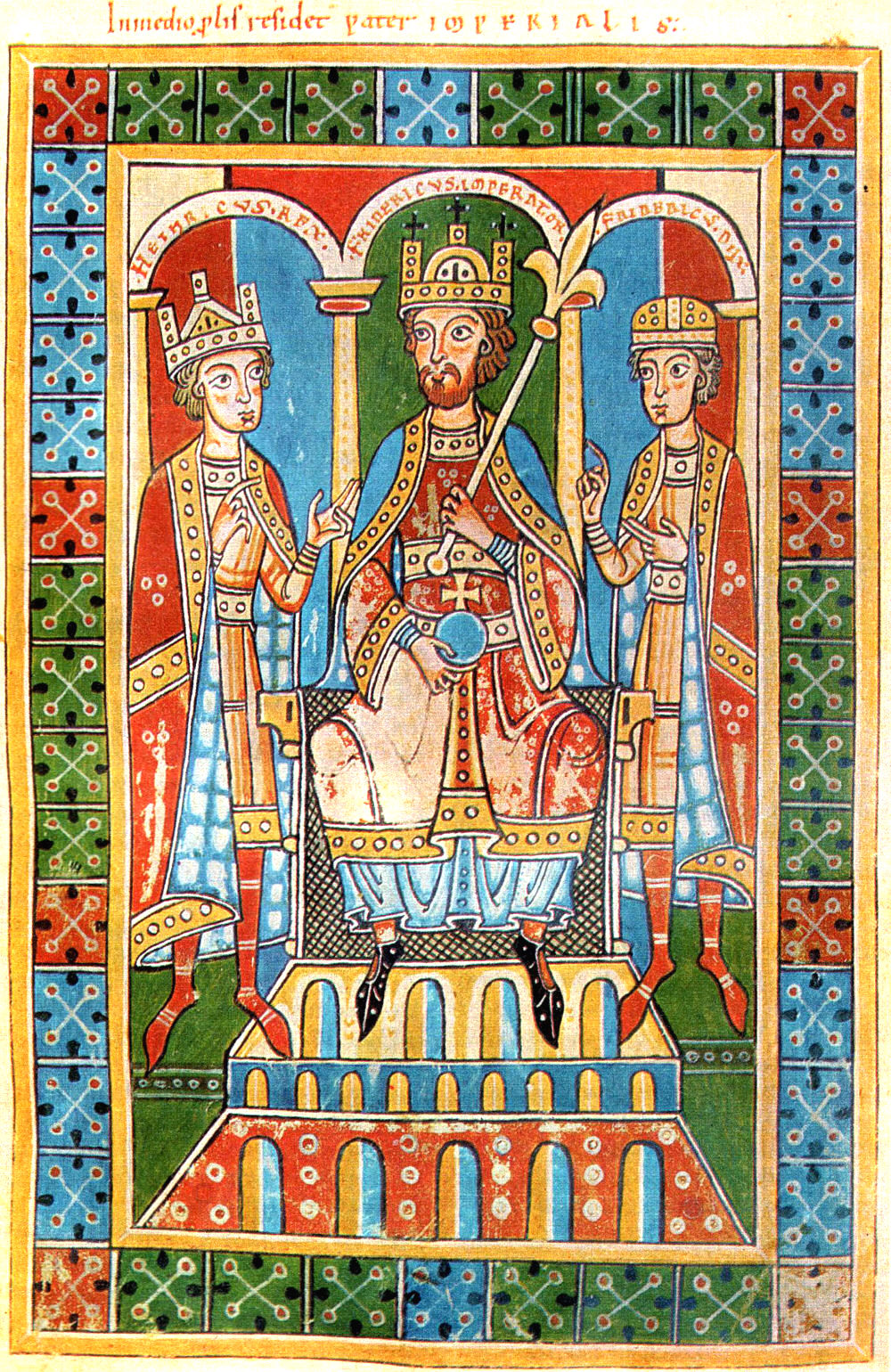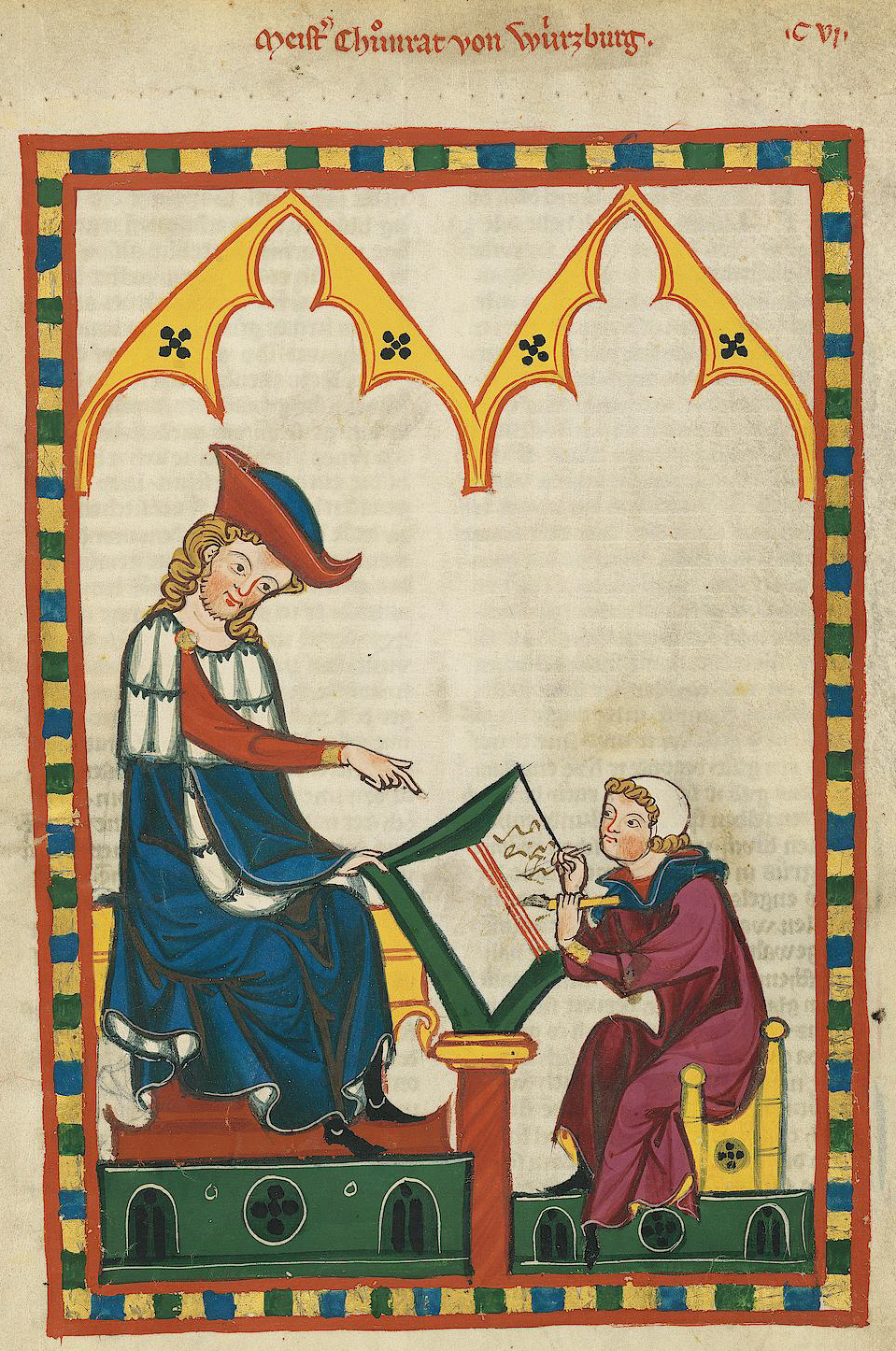|
Minnesingers
(; "love song") was a tradition of lyric- and song-writing in Germany and Austria that flourished in the Middle High German period. This period of medieval German literature began in the 12th century and continued into the 14th. People who wrote and performed ''Minnesang'' were known as ''Minnesänger'' (), and a single song was called a ''Minnelied'' (). The name derives from ''minne'', the Middle High German word for love, as that was ''Minnesang'''s main subject. The ''Minnesänger'' were similar to the Provençal troubadours and northern French ''trouvères'' in that they wrote love poetry in the tradition of courtly love in the High Middle Ages. Social status In the absence of reliable biographical information, there has been debate about the social status of the ''Minnesänger''. Some clearly belonged to the higher nobility – the 14th century Codex Manesse includes songs by dukes, counts, kings, and the Emperor Henry VI. Some ''Minnesänger'', as indicated by the ... [...More Info...] [...Related Items...] OR: [Wikipedia] [Google] [Baidu] |
Walther Von Der Vogelweide
Walther von der Vogelweide (c. 1170c. 1230) was a Minnesänger who composed and performed love-songs and political songs (" Sprüche") in Middle High German. Walther has been described as the greatest German lyrical poet before Goethe; his hundred or so love-songs are widely regarded as the pinnacle of Minnesang, the medieval German love lyric, and his innovations breathed new life into the tradition of courtly love. He was also the first political poet to write in German, with a considerable body of encomium, satire, invective, and moralising. Little is known about Walther's life. He was a travelling singer who performed for patrons at various princely courts in the states of the Holy Roman Empire. He is particularly associated with the Babenberg court in Vienna. Later in life he was given a small fief by the future Holy Roman Emperor, Frederick II. His work was widely celebrated in his time and in succeeding generations—for the Meistersingers he was a songwriter to emulate ... [...More Info...] [...Related Items...] OR: [Wikipedia] [Google] [Baidu] |
Friedrich Von Hausen
Friedrich von Hausen (Middle High German: Friderich von Hûsen) was a medieval German poet, one of the earliest of the Minnesingers; born sometime between 1150–60; d. 6 May 1190. Life His name is mentioned frequently in legal documents, for the first time in one from Mainz dated 1171 by Christian I, Archbishop of Mainz. He was born in middle Rhenish territory, as is shown by his dialect, especially by his rhymes, but several towns claim to be his birthplace, and the question cannot be definitely decided. In 1175 he was in Italy, and again in 1186 in the suite of Henry VI, Holy Roman Emperor. The next year he was present when Frederick I, Barbarossa and Philip Augustus met between Mouzon and Yvois, and in 1188 he was at Worms in the company of Baldwin V, Count of Hainaut. He accompanied the Emperor Frederick, by whom he was held in high esteem, on the Third Crusade in 1189, and met his death at the battle of Philomelium (modern-day Akşehir, Turkey), when he fell with his horse ... [...More Info...] [...Related Items...] OR: [Wikipedia] [Google] [Baidu] |
Dietmar Von Aist
Dietmar von Aist (c. 1115 – c. 1171) was a Minnesinger from a baronial family in the Duchy of Austria, whose work is representative of the lyric poetry in the Danube region. Life One Dietmar von Aist is mentioned by name from about 1139 onwards in contemporary records from Salzburg, Regensburg and Vienna. The surname probably refers to the Aist River, a left tributary of the Danube below the confluence with the Enns. Since about 1125 the noble family von Aist is evidenced in the Mühlviertel region (present-day Upper Austria), where today the ruins of the ancestral seat stand on the Aist River. The Upper Austrian Aistersheim water castle was first mentioned in 1159 together with ''Freiherr'' (Baron) Dietmar von Aist, a ''ministerialis'' of the Babenberg ruler Henry II of Austria. If he is really identical with the poet is not completely certain on chronological grounds. A certain ''Ditmarus de Agasta'' mentioned in further records, who died childless about 1171, is possibl ... [...More Info...] [...Related Items...] OR: [Wikipedia] [Google] [Baidu] |
Der Von Kürenberg
Der von Kürenberg or Der Kürenberger (fl. mid-12th century) was a Middle High German poet and one of the earliest Minnesänger. Fifteen strophes of his songs are preserved in the Codex Manesse and the Budapest Fragment. Life Since his given name remains unknown ("Der" is not a name but a demonstrative pronoun), it is impossible to identify him in historical records. His social status also remains uncertain and the place name Kürenberg (literally "Mill Hill") is not uncommon. Although he is placed among the barons ("Freiherren") in the hierarchical ordering of the Manesse Codex, the only known house of this status and name is documented in the Breisgau in the 11th Century. He more probably belongs to families of his name with vassal status ("Dienstmann"), attested in the area along the Danube around Melk and Linz in the mid-12th Century. A Danubian origin is also supported by his use of a strophic form identical to that later used in the Nibelungenlied, the "Nibelungenstrophe". ... [...More Info...] [...Related Items...] OR: [Wikipedia] [Google] [Baidu] |
Hartmann Von Aue
Hartmann von Aue, also known as Hartmann von Ouwe, (born ''c.'' 1160–70, died ''c.'' 1210–20) was a German knight and poet. With his works including ''Erec'', '' Iwein'', ''Gregorius'', and ''Der arme Heinrich'', he introduced the Arthurian romance into German literature and, with Wolfram von Eschenbach and Gottfried von Strassburg, was one of the three great epic poets of Middle High German literature. Life Hartmann belonged to the lower nobility of Swabia, where he was born. After receiving a monastic education, he became retainer (''Dienstmann'') of a nobleman whose domain, Aue, has been identified with Obernau on the River Neckar. He also took part in the Crusade of 1197. The date of his death is as uncertain as that of his birth; he is mentioned in Gottfried von Strassburg's ''Tristan'' (c. 1210) as still alive, and in the '' Crône'' of Heinrich von dem Türlin, written about 1220, he is mourned for as dead. Works Hartmann produced four narrative poems which are of i ... [...More Info...] [...Related Items...] OR: [Wikipedia] [Google] [Baidu] |
Wolfram Von Eschenbach
Wolfram von Eschenbach (; – ) was a German knight, poet and composer, regarded as one of the greatest epic poets of medieval German literature. As a Minnesinger, he also wrote lyric poetry. Life Little is known of Wolfram's life. There are no historical documents which mention him, and his works are the sole source of evidence. In ''Parzival'', he talks of ''wir Beier'' ("we Bavarians"); the dialect of his works is East Franconian. This and a number of geographical references have resulted in the present-day Wolframs-Eschenbach, until 1917 Obereschenbach, near Ansbach in present-day Bavaria, being officially designated as his birthplace. However, the evidence is circumstantial and not without problems - there are at least four other places named Eschenbach in Bavaria, and Wolframs-Eschenbach was not part of the Duchy of Bavaria ('' Altbayern'') in Wolfram's time. The arms shown in the Manesse manuscript come from the imagination of a 14th-century artist, drawing on the f ... [...More Info...] [...Related Items...] OR: [Wikipedia] [Google] [Baidu] |
Heinrich Von Veldeke
Heinrich von Veldeke (aka: , Dutch Hendrik van Veldeke, born before or around 1150 – died after 1184) is the first writer in the Low Countries known by name who wrote in a European language other than Latin. He was born in Veldeke, which was a hamlet of Spalbeek, part of the municipality of Hasselt, Limburg, Belgium, since 1977. The "", a water mill on the Demer River, is the only remainder of the hamlet. In Limburg, he is celebrated as a writer of Old Limburgish. Veldeke's years of birth and death are uncertain. He must have been born before or around 1150, as he was writing in the early 1170s. There is no evidence that Veldeke was born in 1128, as is often suggested. He certainly died after 1184 because he mentions in his ''Eneas'' that he was present at the court day that Emperor Frederik Barbarossa organised in Mainz at Pentecost of that year. He must have died before Wolfram von Eschenbach wrote his ''Parzival'', which was completed between 1205 and 1210. Wolfram mentions ... [...More Info...] [...Related Items...] OR: [Wikipedia] [Google] [Baidu] |
Henry VI, Holy Roman Emperor
Henry VI (German: ''Heinrich VI.''; November 1165 – 28 September 1197), a member of the Hohenstaufen dynasty, was King of Germany ( King of the Romans) from 1169 and Holy Roman Emperor from 1191 until his death. From 1194 he was also King of Sicily. Henry was the second son of Emperor Frederick Barbarossa and Beatrice I, Countess of Burgundy. Well educated in the Latin language, as well as Roman and canon law, Henry was also a patron of poets and a skilled poet himself. In 1186 he was married to Constance of Sicily, the posthumous daughter of the Norman king Roger II of Sicily. Henry, stuck in the Hohenstaufen conflict with the House of Welf until 1194, had to enforce the inheritance claims by his wife against her nephew Count Tancred of Lecce. Henry's attempt to conquer the Kingdom of Sicily failed at the siege of Naples in 1191 due to an epidemic, with Empress Constance captured. Based on an enormous ransom for the release and submission of King Richard I of England, he ... [...More Info...] [...Related Items...] OR: [Wikipedia] [Google] [Baidu] |
Konrad Von Würzburg
Konrad von Würzburg (c.1220-1230 – 31 August 1287) was the chief German poet of the second half of the 13th century. As with most epic poets of the age, little is known of his life, and his origin is disputed. There have been German scholars and local patriots of Würzburg who claimed he hailed from Würzburg. Wilhelm Wackernagel on the other hand contends that Konrad was from Basel, as the house he owned was called the "House of Wirzburg", meaning he was named "Würzburg" not after a city, but after a house. He seems to have spent part of his life in Strasbourg and his later years in Basel, where he died. Like his master, Gottfried von Strassburg, but unlike most other poets from the time, Würzburg did not belong to the nobility. His varied and voluminous literary work is comparatively free from the degeneration which set in so rapidly in Middle High German poetry during the 13th century. According to the ''Encyclopædia Britannica'' Eleventh Edition, " s style, alt ... [...More Info...] [...Related Items...] OR: [Wikipedia] [Google] [Baidu] |
Codex Manesse Walther Von Der Vogelweide
The codex (plural codices ) was the historical ancestor of the modern book. Instead of being composed of sheets of paper, it used sheets of vellum, papyrus, or other materials. The term ''codex'' is often used for ancient manuscript books, with handwritten contents. A codex, much like the modern book, is bound by stacking the pages and securing one set of edges by a variety of methods over the centuries, yet in a form analogous to modern bookbinding. Modern books are divided into paperback or softback and those bound with stiff boards, called hardbacks. Elaborate historical bindings are called treasure bindings. At least in the Western world, the main alternative to the paged codex format for a long document was the continuous scroll, which was the dominant form of document in the Ancient history, ancient world. Some codices are continuously folded like a concertina, in particular the Maya codices and Aztec codices, which are actually long sheets of paper or animal skin folded ... [...More Info...] [...Related Items...] OR: [Wikipedia] [Google] [Baidu] |
Canzone
Literally "song" in Italian, a ''canzone'' (, plural: ''canzoni''; cognate with English ''to chant'') is an Italian or Provençal song or ballad. It is also used to describe a type of lyric which resembles a madrigal. Sometimes a composition which is simple and songlike is designated as a canzone, especially if it is by a non-Italian; a good example is the aria "Voi che sapete" from Mozart's Marriage of Figaro. The term canzone is also used interchangeably with canzona, an important Italian instrumental form of the late 16th and early 17th century. Often works designated as such are ''canzoni da sonar''; these pieces are an important precursor to the sonata. Terminology was lax in the late Renaissance and early Baroque music periods, and what one composer might call "canzoni da sonar" might be termed "canzona" by another, or even "fantasia". In the work of some composers, such as Paolo Quagliati, the terms seem to have had no formal implication at all. Derived from the Pro ... [...More Info...] [...Related Items...] OR: [Wikipedia] [Google] [Baidu] |
Strophic Form
Strophic form – also called verse-repeating form, chorus form, AAA song form, or one-part song form – is a song structure in which all verses or stanzas of the text are sung to the same music. Contrasting song forms include through-composed, with new music written for every stanza, and ternary form, with a contrasting central section. The term is derived from the Greek word , '' strophē'', meaning "turn". It is the simplest and most durable of musical forms, extending a piece of music by repetition of a single formal section. This may be analyzed as "A A A...". This additive method is the musical analogue of repeated stanzas in poetry or lyrics and, in fact, where the text repeats the same rhyme scheme from one stanza to the next, the song's structure also often uses either the same or very similar material from one stanza to the next. A ''modified'' strophic form varies the pattern in some stanzas (A A' A"...) somewhat like a rudimentary theme and variations. Contrasting ... [...More Info...] [...Related Items...] OR: [Wikipedia] [Google] [Baidu] |







